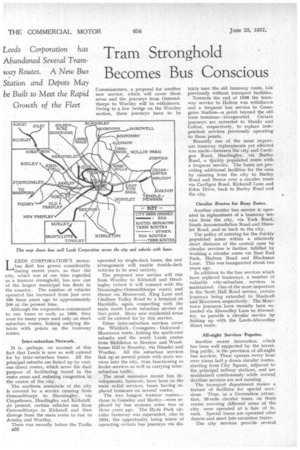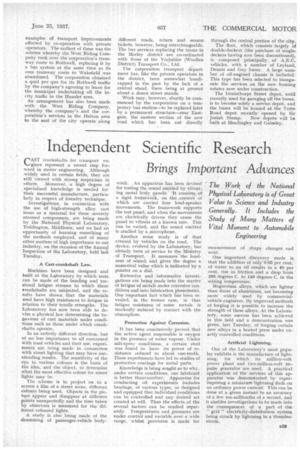Tram Stronghold Becomes Bus Conscious
Page 42

Page 43

If you've noticed an error in this article please click here to report it so we can fix it.
LEEDS CORPORATION'S motorbus fleet has grown considerably during recent years, so that the city, which was at one time regarded as a tramcar stronghold, has now one of the largest municipal bus fleets in the country. The number of vehicles operated has increased from just over 100 three years ago to approximately 200 at the present time.
Although the corporation commenced to run buses so early as 1906, they were for many years used only on short suburban routes, linking outlying districts with points on the tramway routes.
Inter-suburban Network.
It is, perhaps, on account of this fact that Leeds is now so well catered for by inter-suburban buses. All the principal suburbs are linked up by various direct routes, which serve the dual purpose of facilitating travel in the outer areas and reducing congestion in the centre of the city. .
The northern, semicircle of the city is covered by a service running from Osmondthorpe to Stanningley, via Chapeltown, Headingley and Kirkstall. At present, certain vehicles run from Osmondthorpe to Kirkstall and then diverge from the main route to run to Armley and Wortley.
There was recently before the Traffic B28
Commissioners, a proposal for another new set-vice, which will cover these areas and the journeys from Osmondthorpe to 'Wortley will be withdrawn. Owing to a low bridge on the Wortley section, these journeys have to be
operated by single-deck buses; the new arrangement will enable double-deck vehicles to be used entirely.
The proposed new service will run from Wortley to Kirkstall and Headingley (where it will connect with the Stanningley-Osrnondthorpe route) and thence via Meanwood, King Lane and Gledhow Valley Road to a terminal at Harehills, again connecting with the main north Leeds suburban service at that point. Many new residential areas will he catered for by this service.
Other inter-suburban services cover the Whitkirk Crossgates Oakwood Moortown route, linking the north-east suburbs and the south Leeds 'mites from Middleton to Beeston and Woodhouse Hill to Bramley, via Hunslet and Wortley. All the suburban services link up at several points with main services into the city, thus functioning as feeder services as well as carrying intersuburban traffic.
The most extensive recent bus developments, however, have been on the main radial services, buses having replaced tramcars on several routes.
The two longest tramcar routes— those to Guiseley and Morley—were replaced by bus systems some two or three years ago. The Hyde Park circular tramway was superseded, also in 1934, the opportunity being taken of operating certain bus journeys via dis
tricts near the old tramway route, bat previously without transport facilities.
Towards the end of 1936 the tramway service to Halton was withdrawn and a frequent bus service to Crossgates Station—a point beyond the old tram terminus—inaugurated. Certain journeys are extended to Stanks and Colton, respectively, to replace independent services previously operating to those points.
Recently one of the most important tramway replac9ments yet effected was made—between the city and Cardigan Road, Headingley, via Burley Road, a thickly populated route with a frequent service. The buses are providing additional facilities for the area by running from the city to Burley Road and thenee over a circular route via Cardigan Road, Kirkstall Lane and Eden Drive, back to Burley Road and the city.
Circular Routes for Busy Zones.
Another circular bus service is operated in replacement of a tramway service from the city, via York Road, South Accommodation Road and Hunslet Road, and so back to the city.
The policy of catering for the thickly populated areas within a relatively short distance of the central zone by circular services is further fulfilled by working a circular route via East End Park, Hudson Road and Blackman Lane. This was inaugurated about two years ago. In addition to the bus services which have replaced tramways, a number of valuable city-suburban, services is maintained, One of the most important is the Scott Hall Road service, certain journeys being extended to Shadivell and Moortown respectively. The Moo rtown journeys have recently been extended via Ahvoodley Lane to Alwoodley, to provide a circular service by linking up with the Leeds-Alwoodley direct route.
All-night Services Popular.
Another recent innovation, which has been well supported by the travelling public, is the provision of all-night bus services. These cperate every hour over, about half a dozen circular routes, starting from City Square, adjacent to the principal railway stations, and are maintained continuously while normal daytime services are not running.
The transport department makes a feature of facilities for special occasions. Thus, as a Corenation attraction, 20-mile circular tours, on three routes covering different areas of the city, were operated at a fare of Is. each. Special buses are operated after dances and meet late excursion trains. The city services provide several examples of transport improvements effected by co-operation with private operators. The earliest of these was the scheme whereby the West Riding Company took over the corporation's tramway route to Rothwell, replacing it by a bps system at the same time as its own tramway route to Wakefield was abandoned. The corporation obtained a quid pro quo for its Rothwell traffic by the company's agreeing to leave for the municipal undertaking all the incity traffic in the Hunslet area.
An arrangement has also been made with the West Riding Company, whereby the company's and the corporation's services in the Halton area to the east of the city operate along
different roads, return and season tickets, however, being interchangeable. The bus services replacing the trams in the Morley district . are co-ordinated -with those of the Yorkshire (Woollen
District) Transport Co., Ltd. _ . The corporation transport department has, like the private operators in the district, been somewhat handicapped in the past by the lack of a central stand, there being at present about a dozen street stands.
Work may, however, shortly be commenced by the corporation on a temporary bus station—to be replaced later by a permanent structure—near Eastgate, the eastern section of the new road which has been cut directly through the central portion of the city.
The fleet, which consists largely of double-deckers (the purchase of single-. deckers having now been discontinued), is composed principally of A.E.C. vehicles,with a number of Leyland, Dennis and Guy buses. A large number of oil-engined chassis is included. This type has been selected to inaugurate the services on the new housing estates now under construction.
. The Isonisthorpe Street depot, until recently used for garaging all the buses, is to become solely a service depot, and the buses will be housed at the Tofre Road depot recently opened by Sir Josiah Stamp. New depots will be built at Headingley and Guiseley.




























































































